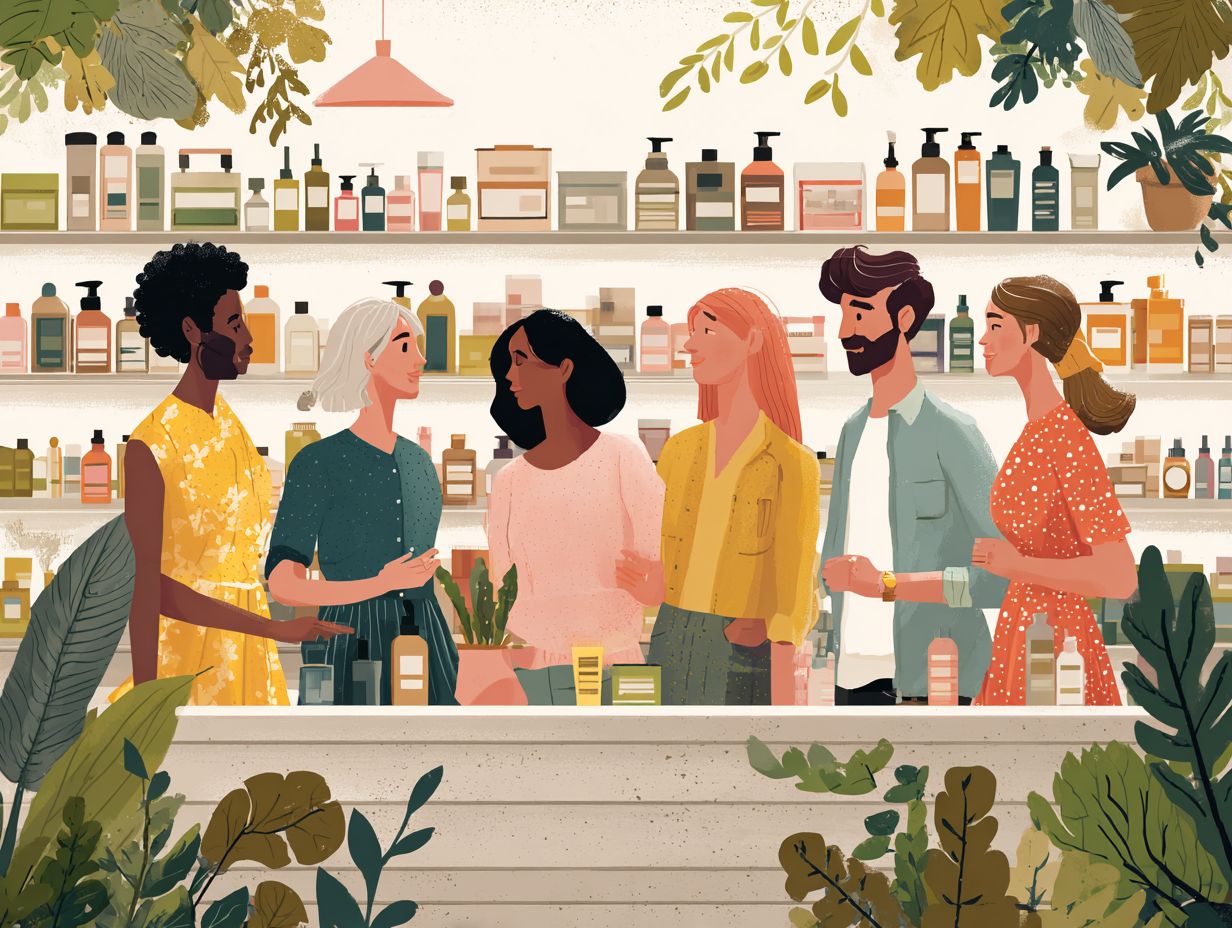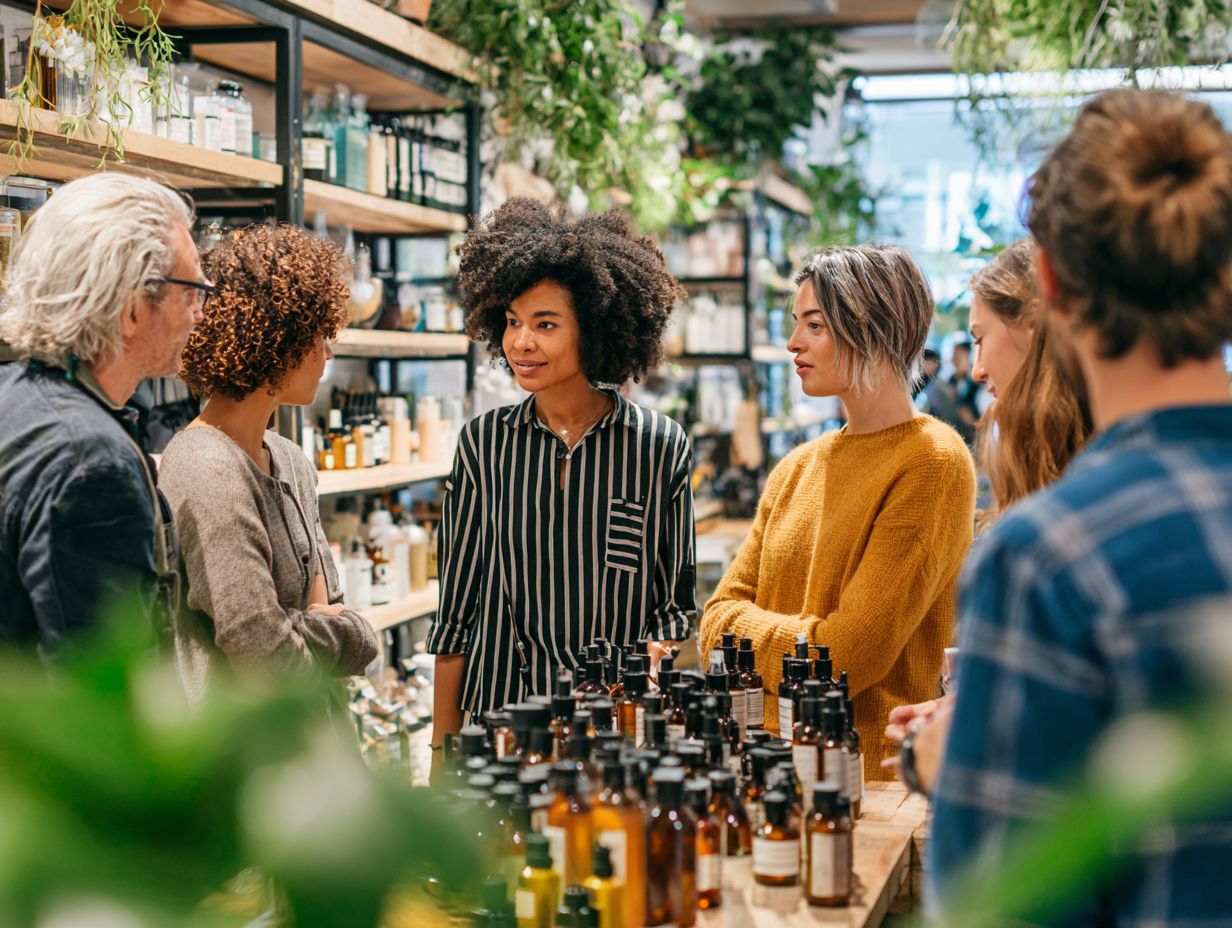In recent years, I have observed a significant shift in the beauty industry towards clean beauty, a movement that prioritizes products that are safe for both our bodies and the environment. With an increasing demand for transparency, it has become essential for me to understand what clean beauty truly means and why it is important. This article will delve into the evolution of clean beauty regulations, highlight harmful ingredients to avoid, and provide practical tips for identifying clean products. I invite you to explore the benefits of transitioning to a clean beauty routine and discover how it can enhance not only your skin but your overall well-being.
Key Takeaways:
Understanding Clean Beauty

Understanding clean beauty is essential, as it represents a significant movement toward safer, effective, and environmentally sustainable beauty products. This movement aligns with consumer expectations for transparency in ingredient sourcing, ethical practices, and brand integrity.
As I observe consumers becoming more aware of the harmful effects of toxic chemicals in cosmetics, it is evident that the demand for clean beauty products is on the rise. This shift is prompting brands to adapt their operations and comply with evolving regulatory frameworks that prioritize product safety and sustainability. According to Forbes, there has been a notable increase in shopper demand for clean beauty, emphasizing the importance of transparency and ethical practices in the industry.
Defining Clean Beauty and its Importance
Clean beauty refers to beauty products that are formulated without harmful ingredients, emphasizing product safety, regulatory compliance, and sustainability-an aspect that is increasingly important to consumers today.
This movement prioritizes transparency in formulations, ensuring that products utilize naturally derived, non-toxic components that match the effectiveness of traditionally used chemicals, thereby enhancing ingredient safety.
As a consumer, I have become more discerning, not only questioning what I apply to my skin but also considering the origins of these ingredients and their environmental impact.
By avoiding toxic chemicals commonly linked to adverse health effects, the clean beauty trend represents a shift towards a healthier lifestyle and enhances consumer trust in brands that prioritize ethical practices and adhere to cosmetic regulations.
This commitment to sustainability resonates strongly with a growing audience that values eco-friendliness and community well-being, marking a significant transformation in the beauty industry.
The Evolution of Clean Beauty Regulations
The evolution of clean beauty regulations has been characterized by heightened scrutiny and a growing demand for transparency within the cosmetic industry.
This shift has been significantly influenced by the introduction of frameworks such as the FDA’s MoCRA compliance, which is designed to enhance consumer safety and build trust. For those interested in a comprehensive overview, this analysis by the FDA covers the full spectrum of implications.
History and Current State of Regulations
The history of cosmetic regulations spans several decades, marked by evolving guidelines that reflect society’s increasing awareness of health concerns associated with the beauty industry.
In the early 20th century, the lack of oversight allowed harmful ingredients to infiltrate cosmetic products. However, the landmark Federal Food, Drug, and Cosmetic Act of 1938 established fundamental safety requirements, leading to significant transformations in the regulatory landscape.
More recently, the rise of the clean beauty movement has intensified scrutiny around ingredient transparency and safety. Today, regulations enforced by agencies such as the FDA not only protect consumers but also challenge brands to uphold integrity in their formulations.
This shift has fostered greater consumer trust, as shoppers increasingly demand accountability from their preferred beauty products. As a result, brands are now under close examination, where strict adherence to safety and ethical guidelines can significantly impact their reputation.
Key Ingredients to Avoid
I find it essential to identify key ingredients to avoid, as this knowledge enables consumers to ensure product safety and mitigate health concerns associated with harmful chemicals commonly found in beauty products.
Harmful Chemicals and their Effects

Harmful chemicals such as parabens, sulfates, and phthalates are often present in conventional beauty products, raising significant health concerns and driving the clean beauty movement.
These substances, commonly found in lotions, shampoos, and skincare items, have been associated with various adverse effects, including hormone disruption and skin irritation. As I become more informed about the potential dangers of these chemicals, I notice a growing demand for transparency in labeling practices.
This awareness is a key factor fueling the clean beauty movement, encouraging brands to reformulate their products with safer and ethically sourced ingredients.
Empowered by this knowledge, I prioritize products that are free from harmful additives, which in turn encourages the beauty industry to adopt cleaner, more sustainable practices that promote overall wellbeing, a conclusion supported by the Environmental Working Group’s insights on The Toxic Twelve Chemicals and Contaminants in Cosmetics.
How to Identify Clean Beauty Products
In identifying clean beauty products, I focus on looking for specific certifications and labels that indicate compliance with safety, ethical sourcing, and labor ethics standards.
This approach ensures transparency throughout the supply chain and helps me make informed choices as a consumer, while also considering digital tools and blockchain technology for enhanced traceability.
Certifications and Labels to Look For
When I shop for clean beauty products, I prioritize reputable certifications such as UEBT standards and labels that signify ethical sourcing and sustainability practices.
These certifications not only help guide me toward more responsible choices but also ensure that the brands I support adhere to specific environmental and social criteria.
For example, certifications from organizations like EcoCert and the Leaping Bunny program provide me with the assurance that the products are free from harmful chemicals and cruelty-free, respectively. Additionally, the Soil Association plays a vital role by offering organic certification, which verifies the ecological integrity of beauty products.
By understanding these labels, I am enableed to support brands that are committed to transparency and ethical practices, ultimately contributing to a positive impact on both the environment and the communities involved in the production processes.
The Benefits of Switching to Clean Beauty Products
The advantages of transitioning to clean beauty products go beyond enhancing personal health. This shift also contributes positively to the environment and cultivates greater consumer trust in brands that prioritize sustainability.
Improvements in Skin and Overall Health
Switching to clean beauty products often results in considerable improvements in skin health, as these formulations are free from harmful chemicals that can aggravate various health issues, thus avoiding consumer backlash.
By choosing these products, I have noticed a significant reduction in irritations and allergic reactions, which frequently arise from the synthetic additives commonly found in traditional cosmetics. Clean beauty items prioritize natural and nourishing ingredients like plant-based oils, organic extracts, and essential vitamins, all of which work together to hydrate and rejuvenate the skin.
The absence of toxic components not only supports skin health but also reduces the risk of long-term damage, thereby enhancing overall vitality. Over time, I have observed improvements in my skin texture, achieving a more radiant complexion that is free from harmful residues.
Environmental Impact

The environmental impact of clean beauty is significant, as these products often prioritize sustainability and biodiversity preservation, thereby reducing the overall footprint of the beauty industry.
By focusing on eco-friendly product formulations, I ensure that the ingredients I use are sourced responsibly, often from renewable resources that are designed to minimize harm to the planet. Many leaders in the industry are now embracing sustainable practices, such as utilizing biodegradable packaging and reducing waste in their production processes.
This commitment not only demonstrates a strong dedication to environmental stewardship but also resonates with consumers who are increasingly seeking ethical choices.
As a result, the clean beauty movement fosters a culture of transparency and responsibility, promoting partnerships with organizations dedicated to ecological preservation and advocating for innovations that prioritize planetary health over mere profit.
Transitioning to a Clean Beauty Routine
Transitioning to a clean beauty routine can be accomplished through the careful selection of beauty products and the adoption of sustainable practices.
This approach not only fosters consumer trust but also demonstrates a commitment to health and well-being.
Tips for Making the Switch
To successfully transition to clean beauty, I begin by thoroughly reviewing ingredient lists, choosing products that prioritize safety, and supporting brands committed to ethical ingredient sourcing.
This initial step is vital as it enables me to identify harmful substances commonly found in conventional beauty products, such as parabens, sulfates, synthetic fragrances, and toxic chemicals. I actively seek certifications like “non-toxic” or “organic” to ensure the quality of the ingredients I use, adhering to UEBT standards and cosmetic safety. Additionally, I consider purchasing from brands that emphasize transparency, providing clear information about their ingredient origins, strategic advantage, and supply chain.
For those of us looking to further enhance our commitment to sustainability, I make an effort to select items housed in recyclable or biodegradable packaging, aligning with sustainability goals. By doing so, I not only safeguard my health but also contribute to a more responsible and eco-friendly beauty industry, fulfilling MoCRA compliance.
Frequently Asked Questions
What are clean beauty regulations and why are they evolving?
Clean beauty regulations refer to the laws and guidelines set in place to regulate the ingredients, product labeling, and labeling requirements of beauty products. These regulations are evolving to keep up with changing consumer demands for safer and more natural products, influenced by beauty trends and beauty justice.
What makes a beauty product “clean”?

A clean beauty product is one that is made with non-toxic, natural, and sustainably sourced ingredients, ensuring manufacturers compliance and risk evaluation. It should also be free from harmful chemicals, parabens, and synthetic fragrances.
How can I know if a beauty product is considered “clean”?
Look for products that are certified by reputable organizations such as the Environmental Working Group, the Clean Label Project, or New York’s Beauty Justice Act. You can also check the ingredient list for any red flag chemicals or do your own research on the brand’s sourcing and production practices.
Are clean beauty regulations the same worldwide?
No, clean beauty regulations vary by country and even by state in some cases. Some countries have stricter regulations, while others have looser guidelines. It’s important to research the regulations in your specific location before purchasing beauty products.
Do clean beauty regulations apply to all types of beauty products?
Yes, clean beauty regulations apply to all types of beauty products including skincare, makeup, haircare, and fragrances, which require safety testing and operational audits. They also apply to both mass-produced and handmade products.
How can I stay informed about evolving clean beauty regulations?
Follow reputable beauty and environmental organizations, read ingredient lists and labels carefully, and stay up to date with any news or changes in regulations, leveraging insights from Ekwani Consulting and EcoMundo. You can also reach out to brands directly to inquire about their practices and ingredients.


